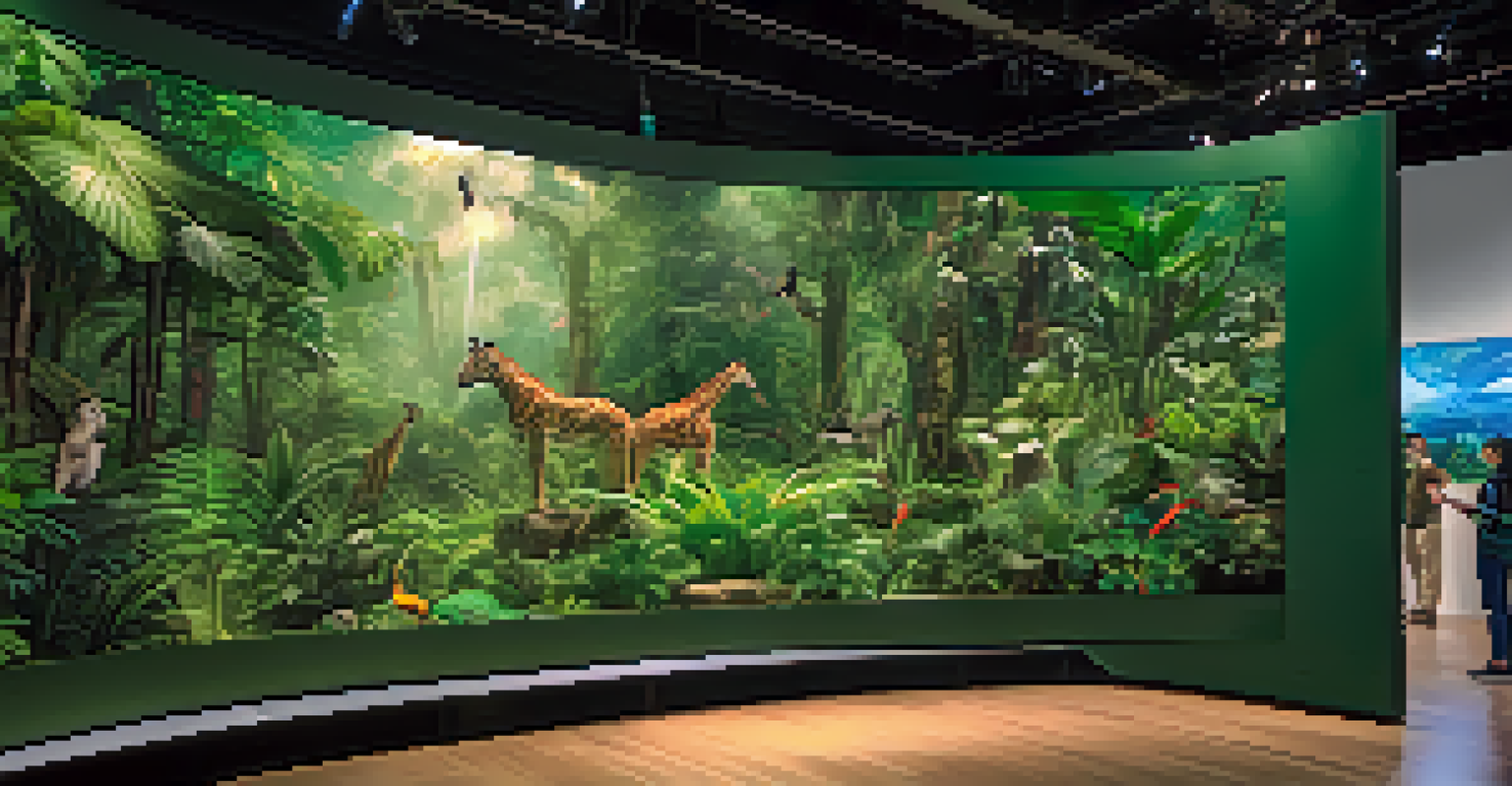The Importance of Environmental Themes in Modern Art

Understanding Environmental Themes in Art
Environmental themes in art refer to the ways artists address ecological issues through their work. These themes often explore the relationship between humanity and nature, highlighting both the beauty of the natural world and the challenges it faces. By engaging with concepts like climate change, pollution, and biodiversity, artists can evoke emotional responses and provoke thought about our impact on the planet.
Art is a form of consciousness, a way to engage with the world and evoke change.
Modern art has evolved to incorporate these themes, reflecting a growing awareness of environmental concerns. Artists use various mediums—from painting and sculpture to installations and digital art—to convey their messages. This diversity allows for a rich exploration of how we perceive and interact with our environment.
In this context, art serves not just as a form of expression but also as a tool for advocacy. It can raise awareness, inspire action, and foster a deeper connection to the natural world, encouraging viewers to reflect on their role in preserving it.
The Role of Artists as Environmental Advocates
Many contemporary artists see themselves as advocates for the environment, using their platforms to drive social change. Through their work, they can highlight urgent issues like deforestation, ocean pollution, and climate change. By doing so, they invite audiences to consider the ramifications of these issues on both local and global scales.

For instance, artists like Olafur Eliasson create immersive installations that encourage viewers to engage with environmental concepts firsthand. His works often utilize natural elements, prompting reflection on our relationship with the planet. Such experiences can be transformative, leading to a more profound understanding of ecological issues.
Art as Environmental Advocacy
Artists increasingly use their work to raise awareness about ecological issues and inspire social change.
This role of the artist as an advocate has become increasingly vital. In a world where scientific discourse on climate change can sometimes feel abstract, art makes these concepts tangible and relatable, bridging the gap between information and emotional impact.
Art as a Reflection of Environmental Crisis
Art has a unique ability to reflect societal concerns, and the environmental crisis is no exception. Many modern artists depict the devastating effects of climate change, pollution, and loss of biodiversity in their works. This reflection not only raises awareness but also captures the urgency of the situation, making it impossible for viewers to ignore.
We do not inherit the earth from our ancestors; we borrow it from our children.
For example, the works of artists like Chris Jordan visually illustrate the alarming statistics surrounding waste and consumption. His photography showcases the sheer scale of plastic pollution, creating a visceral impact that statistics alone cannot provide. By transforming data into striking visuals, he invites viewers to confront uncomfortable truths about their consumption habits.
Through such reflections, art becomes a mirror for society, encouraging introspection and dialogue. It challenges viewers to consider their environmental footprint and motivates them to seek solutions to pressing ecological challenges.
Engaging Audiences through Interactive Art
Interactive art has emerged as a powerful way to engage audiences with environmental themes. By inviting participation, artists create immersive experiences that foster a connection between viewers and nature. This engagement can lead to a deeper understanding of environmental issues and inspire collective action.
For instance, installations that require audience interaction, such as planting trees or participating in clean-up activities, can create lasting memories and a sense of community. Artists like Agnes Meyer-Brandis utilize participatory projects to encourage individuals to take an active role in environmental stewardship.
Interactive Art Engages Audiences
Interactive installations invite public participation, fostering a deeper connection to environmental themes.
Such interactions not only make art more accessible but also empower individuals to contribute positively to their environments. By transforming passive viewers into active participants, interactive art can cultivate a sense of responsibility toward the planet.
Cultural Perspectives on Environmental Art
Environmental themes in art are often influenced by cultural perspectives, showcasing diverse interpretations of nature and ecology. Different cultures have unique relationships with the environment, which can shape how artists respond to ecological issues. By exploring these varied perspectives, we gain a richer understanding of global environmental challenges.
Indigenous artists, for example, often incorporate traditional ecological knowledge into their work, emphasizing the interconnectedness of all living things. This approach highlights the importance of sustainability and respect for nature, offering valuable insights into how we can live harmoniously with our surroundings.
By celebrating these cultural narratives through art, we can foster greater appreciation for diverse environmental philosophies. This cultural lens not only enriches our understanding of nature but also encourages collaboration across communities to address shared ecological concerns.
The Impact of Technology on Environmental Art
Technology has significantly transformed the landscape of modern art, providing new tools for artists to explore environmental themes. Digital art, virtual reality, and augmented reality offer innovative ways to engage audiences and present ecological issues. These technological advancements can enhance storytelling, making environmental concerns more relatable and impactful.
For example, virtual reality experiences can immerse viewers in endangered ecosystems, allowing them to witness the beauty of these environments and the threats they face. Such experiences can create empathy and a sense of urgency, motivating individuals to take action in their own lives.
Cultural Perspectives Enrich Art
Diverse cultural interpretations of nature shape how artists respond to and portray environmental challenges.
As technology continues to evolve, so too does the potential for environmental art to inspire change. By leveraging these tools, artists can reach wider audiences and create compelling narratives that resonate with contemporary societal concerns.
The Future of Environmental Themes in Art
As awareness of environmental issues continues to grow, the relevance of environmental themes in art is likely to expand. Artists will increasingly explore innovative ways to address ecological concerns, pushing the boundaries of creativity and advocacy. This evolution can lead to more impactful art that not only reflects current challenges but also envisions a sustainable future.
Moreover, collaboration between artists, scientists, and activists is likely to become more common. By combining their expertise, these groups can create multifaceted projects that educate and inspire audiences. Such partnerships can amplify the message of environmental stewardship and encourage collective action.

Ultimately, the future of environmental themes in art is bright, filled with potential for meaningful engagement and social change. As long as artists continue to challenge perceptions and provoke thought through their work, the conversation around environmental issues will remain vibrant and vital.